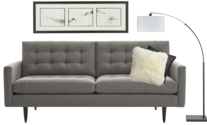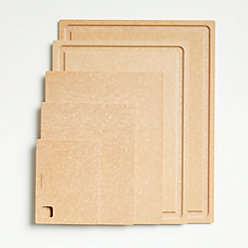Why They’re Essential
Yes, you really need a cutting board. Cutting directly on your counters is comparable to running your knives through a grinder. Knives need TLC, and the best way you can keep them sharp is to use them on friendly surfaces. Your countertops need equal protection from sharp knives and the food you’re working with; cutting boards provide an extra layer, keeping marble and other materials safe from scrapes, scratches and stains. Moreover, the boards keep the food you’re prepping contained, so you can efficiently transfer ingredients to bowls, plates and saute pans.
Wood / Boos
Wood cutting boards have a variety of benefits: They won’t unnecessarily dull your knives’ edges, and their weight makes them sturdy enough to stay put while you chop (safety first). Many come fitted with a channel around the perimeter to catch liquid runoff from carving meats and stray bits of food. The sturdiest and most knife-safe among the wood family are end-grain cutting boards, whose checkered appearance comes from combining small blocks of wood together. We favor several cutting board brands, but the best known in the food community is probably John Boos, an Illinois-based company that’s been around since the early 19th century. Boos cutting boards are prized for being as beautiful as they are well-made, and come in a variety of shapes (circle, square, rectangle) and sizes. If you settle on wood cutting boards, keep in mind they should never see the inside of a dishwasher; they require hand-washing plus a bit of maintenance to keep them looking their best.

Plastic
Plastic cutting boards provide a lightweight, colorful, dishwasher-safe alternative to wood. Restaurants generally favor plastic or rubber boards, and use a color coding system to avoid cross-contamination that you can easily adapt for your home: red for raw meats, blue for raw seafood, green for produce, white for dairy, and so on. You can rest assured that our BPA-free plastic cutting boards will never transfer harmful chemicals to your food. In fact, most are antimicrobial and non-porous.
Bamboo
Of the wood cutting boards available, bamboo is prized for its low environmental impact—technically it’s a grass, not a tree. The wood is also sturdier than most, making it highly functional in the kitchen: It’s particularly moisture-resistant (it won’t soak up stains or create a breeding ground for bacteria), and so sturdy that it’s essentially warp- and crack-proof. It won’t scar much, either, so your bamboo cutting board can be used both in the kitchen and on the table.
Epicurean
Epicurean cutting boards provide the best of both worlds: a wood finish that’s dishwasher-safe. Even better, they’re sustainably produced by an American company using wood pulp certified by the Forest Stewardship Council, a not-for-profit organization that encourages responsible management of the world's forests. Epicurean smartly combines wood and food-safe resin in their boards for an even lower environmental impact. The more you use the dishwasher-safe board, the more beautifully weathered it will appear—and it won’t adversely affect your knives in the slightest.
Maintenance
Wood cutting boards generally require a bit more maintenance than plastic, as they’re not dishwasher-safe. The best way to care for your board is cutting board oil, a food-safe oil that will simultaneously sanitize and moisturize your board, all while giving it a sheen. Beeswax is another popular solution for board upkeep. To use oil or wax, simply apply to the board’s surface, wait a few minutes, and polish with a clean cloth. The more regularly you apply the oil or wax, the better your board will look. For a deeper clean, scrub it with a paste made from equal parts salt, baking soda and water. When you’re finished scrubbing, rinse well with hot water.
Alternate Uses
Cutting boards are more than just functional—some are too beautiful to keep hidden away in the kitchen. We love using smaller, rustic cutting boards as a base for cheese or charcuterie; our larger boards are perfect for serving larger loaves of bread. With reversible boards, you can use the chop-friendly side in the comfort of your kitchen, while the embellished side provides a stellar surface on which to serve hors d’oeuvres. Bigger wooden boards are perfect substitutes for decorative trays on coffee tables and ottomans. Want to create a one-of-a-kind wall clock? Using a drill and a clock hardware kit, drill a hole in the center of a round wood cutting board and add the clock hardware per manufacturer directions. Hang in your kitchen or dining room for interest and organic appeal.
How Many Do You Need?
The number of cutting boards you need depends on how frequently you cook and entertain. We suggest a minimum of three: two large (one for meat, one for produce) and a smaller version, which you can use for everything from prepping bar garnishes to chopping small quantities of herbs.
As you can see, options abound in the cutting board world. Whether your priority is function or aesthetics (or both), we’re certain our guide on how to choose a cutting board will steer you toward one that’s suited just for you.











